Android Lollipop vs Android KitKat: what's the difference?
How sweet is the new Android?
Connectivity and APIs
With Android Lollipop Google is making connectivity a big focus - not just between different handsets, but among different classes of device as well. For example Android TV is now built right into Android Lollipop, helping you easily navigate big screens with smartwatch voice commands, phone gestures, and more.
That's just scratching the surface, but it means your Android experience will be consistent across smartphones, tablets, TVs, smartwatches, and more. At least, that's Google's hope.

Google also wants Lollipop's apps to communicate with one another more than KitKat's do. Examples are simple, like tapping links in Chrome and having them open in specific apps instead of taking you to mobile websites. The OS already does it sometimes, but Google wants it to be more consistent.
This depends quite a bit on app developers taking advantage of Lollipop's 5,000 new APIs. These will make the new Android OS more versatile over time, though their presence might not be noticeable for end users at first.
Google says Lollipop is also better at connecting with Bluetooth and Wi-Fi. For example Lollipop devices won't connect to a Wi-Fi network unless they can verify there's an actual connection there - so unlike with KitKat, you won't be stumped wondering why you suddenly have no data because your gadget decided to connect to a turd of a network.
Safe and sound
Android Lollipop has some new security features as well, like the ability to set geographical "safe zones" where your device won't require a PIN to unlock.
You can do the same with specific Bluetooth devices, like Android Wear smartwatches, which your phone or tablet will sense automatically and turn off its security barriers.
Get daily insight, inspiration and deals in your inbox
Get the hottest deals available in your inbox plus news, reviews, opinion, analysis and more from the TechRadar team.
And despite all the changes to notifications that let you see and interact with them without unlocking your phone, Android 5.0 also has new settings that let you hide sensitive information anywhere it might appear.
Lollipop also has better protection against vulnerabilities and malware thanks to SELinux enforcing for all applications, and encryption is turned on by default on all Lollipop devices.
And multiple user profiles on a single device, including temporary guest profiles, makes it easier to share your phone with others while still maintaining control over your own stuff.
Performance
Google has reportedly also put a lot of work into making Android Lollipop run better under the hood.
KitKat's optional runtime ART is now the standard for Android Lollipop, and Google says it will help make Lollipop run faster, more efficiently and with less hiccups.
That won't harm existing Android apps' compatibility, but it has let Google future-proof Android further against the inevitable onslaught of 64-bit smartphones coming in the near future.

These phones will have more RAM than existing phones with KitKat and other operating systems are capable of packing, which is a huge benefit that only future generations of Lollipop handsets will be able to take advantage of.
For now, though, Google says Android 5.0 is way more power-efficient over its predecessors, with the same phones getting significantly more battery juice out of Lollipop than they did with KitKat.
Multitasking has also been updated with the ability to have multiple cards for the same apps open at a time, letting you have more than one document or website next to one another, for example. It's also easier to switch keyboards now too, and Android Lollipop even supports RAW images.
Availability
Android Lollipop has countless other small improvements over KitKat and other past Android versions, from greater accessibility options and easier set-up to improved graphics capabilities.
Many of these changes won't be noticeable until phone and tablet hardware improves, but that doesn't mean you want to wait until then before you upgrade.
Luckily Android 5.0 Lollipop begins rolling out to devices in late October and early November. Specifics are currently scarce, but keep an eye on TechRadar's Android Lollipop hub for every new update as it happens.
- 1
- 2
Current page: Connectivity, security and performance
Prev Page Interface, design and notificationsMichael Rougeau is a former freelance news writer for TechRadar. Studying at Goldsmiths, University of London, and Northeastern University, Michael has bylines at Kotaku, 1UP, G4, Complex Magazine, Digital Trends, GamesRadar, GameSpot, IFC, Animal New York, @Gamer, Inside the Magic, Comic Book Resources, Zap2It, TabTimes, GameZone, Cheat Code Central, Gameshark, Gameranx, The Industry, Debonair Mag, Kombo, and others.
Micheal also spent time as the Games Editor for Playboy.com, and was the managing editor at GameSpot before becoming an Animal Care Manager for Wags and Walks.

